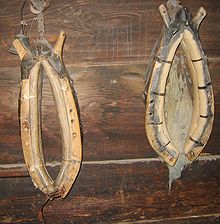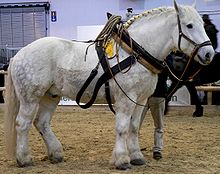
Back Kamonts BAT-SMG Collera Catalan Chomout Czech Сӳсмен CV Kumtesele Danish Ĉevalkolumo Esperanto Collera (arnés) Spanish Rangid Estonian Länget Finnish Collier d'épaule French


A horse collar is a part of a horse harness that is used to distribute the load around a horse's neck and shoulders when pulling a wagon or plough. The collar often supports and pads a pair of curved metal or wooden pieces, called hames, to which the traces of the harness are attached. The collar allows the horse to use its full strength when pulling, essentially enabling the animal to push forward with its hindquarters into the collar. If wearing a yoke or a breastcollar, the horse had to pull with its less-powerful shoulders. The collar had another advantage over the yoke as it reduced pressure on the horse's windpipe.
From the time of the invention of the horse collar, horses became more valuable for plowing and pulling. When the horse was harnessed in the collar, the horse could apply 50% more power to a task in a given time period than could an ox, due to the horse's greater speed.[1][2] Additionally, horses generally have greater endurance than oxen, and thus can work more hours each day. The importance and value of horses as a resource for improving agricultural production increased accordingly.
The horse collar was very important to the development of many areas of the world. Wherever oxen were used and could be replaced with horses, the use of horses boosted economies, and reduced reliance on subsistence farming. This allowed people more free time to take on specialized activities, and consequently to the development of early industry, education, and the arts in the rise of market-based towns.
© MMXXIII Rich X Search. We shall prevail. All rights reserved. Rich X Search